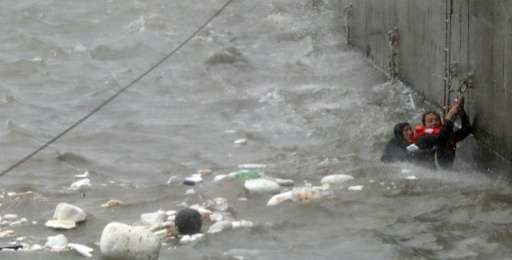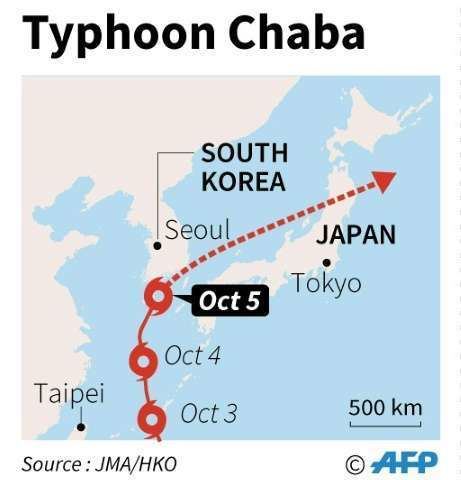Formed September 24, 2016 | Dissipated October 7, 2016 Fatalities 7 | |
 | ||
Highest winds 10-minute sustained: 215 km/h (130 mph)1-minute sustained: 270 km/h (165 mph) Lowest pressure 905 hPa (mbar); 26.72 inHg Damage $18.3 million (2016 USD) Date 24 September 2016 – 7 October 2016 Similar Typhoon Megi, Typhoon Meranti, Typhoon Haima, Typhoon Maemi, Typhoon Nepartak | ||
Typhoon Chaba, known in the Philippines as Typhoon Igme, was the third most intense tropical cyclone in 2016 and the strongest tropical cyclone to make landfall in South Korea since Sanba in 2012. Chaba also caused 7 deaths in the country. Typhoon Chaba was the eighteenth named storm and the eighth typhoon of the 2016 Pacific typhoon season.
Contents

Meteorological history

OnSeptember 26, a tropical depression developed approximately 1,445 km (898 mi) east-northeast of Guam. Despite a marginally favorable environment, the Japan Meteorological Agency (JMA) upgraded the system to a tropical storm and assigned it the name Chaba late the next day. Early on September 28, the Joint Typhoon Warning Center (JTWC) gave the identifier of 21W. Flaring convection and improved overall convective structure prompted the JTWC to upgrade it to a tropical storm. By September 30, Chaba had intensified into a severe tropical storm after deep convection had evolved into a banding feature and very favorable conditions such as very low wind shear and sea surface temperatures (SSTs) of about 30 degrees Celsius. On October 1, Chaba entered the Philippine area of responsibility, with PAGASA assigning the local name Igme, as it started to move in a northwestward direction. Several hours later, both agencies upgraded Chaba to a typhoon after its organization and structure had vastly improved. During the next day, Chaba became more symmetric as feeder bands wrapped into its deep central convection, signalling the onset of explosive intensification.

Continuing its strengthening trend, Chaba reached Category 5 super typhoon intensity with a sharp 5 nmi (9.3 km; 5.8 mi) wide eye surrounded by a very intense convective core due to very warm SSTs. Chaba reached its peak intensity with 10-minute sustained winds of 215 km/h (130 mph), 1-minute sustained winds of 270 km/h (165 mph), and a minimum central pressure of 905 mbar. Thereafter, the JTWC stated that Chaba began weakening, as its core became asymmetric, and Chaba weakened to a strong Category 4 typhoon by October 4. Later, significant weakening led the JTWC to downgrade Chaba further to a Category 2 typhoon, due to interaction with strong north-northeasterly winds. As it neared the coast of Busan, South Korea, Chaba started to undergo extratropical transition and the JTWC issued its final advisory a few hours later, while downgrading the system to a tropical storm. At the same time, the JMA downgraded Chaba to a severe tropical storm. Six hours later, the JMA issued its final advisory, as Chaba became extratropical.
Preparations and impact

EVA Air and China Airlines canceled flights to Okinawa that had been scheduled for 3 October, which was the day the typhoon was scheduled to hit Okinawa. EVA Air had previously been criticized for operating flights to destinations affected by typhoons a week earlier, when Typhoon Megi was affecting the region.
The storm left widespread damage across the southern regions of South Korea, killing at least 7 and leaving 4 missing. Transportation was disrupted, with hundreds of flights canceled, while more than 200,000 households lost electricity. Chaba was the strongest typhoon to strike the country since Maemi in 2003, and was the strongest October typhoon to hit Korea, establishing a new record for rainfall rate on Jeju Island. Flooding was also reported in the southern South Korea cities of Ulsan, Gyeongju, and Busan. The death toll was increased to seven after a missing rescue worker was found dead, and damages were reported at ₩20.3 billion (US$18.3 million)
